#its only carnivorous on the flower stalk and only eats bugs when flowering!
Explore tagged Tumblr posts
Text
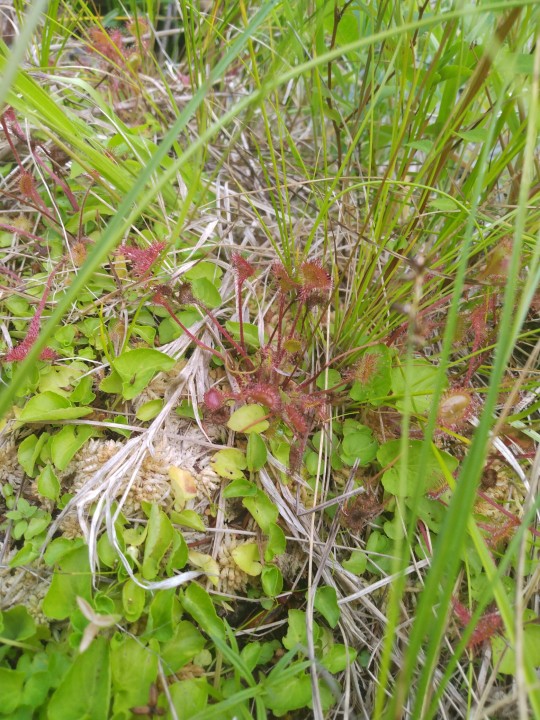

found wild carnivorous plants and wild sphagnum and i identified the triantha occidentalis (red buds in the 2nd picture) correctly without knowing what the plant looked like i only knew the stem was sticky. oh bitch you wish you were me
#its only carnivorous on the flower stalk and only eats bugs when flowering!#drosera#carnivorous plants
7 notes
·
View notes
Text
This time in Mundane Pokémon we have a couple of individual species introductions.

In the world of Mundane, Skitty is one of the most popular Pokémon to be kept as a pet. It's cute, playful, rather small and doesn't have any wild elemental powers, so it's very safe to keep it in an average household and even around children. It also has one huge advantage over many other cat-like Pokémon: Skitty requires moon stone to evolve, so it stays in its base form unless the mineral is deliberately added to its diet.
Pet Skitty has all sort of variations, from many different color morphs to long or curly haired ones. In the wild it is a fairly adaptable species that can live both on its own and in loose colonies. It's a carnivore that stalks pretty much anything small enough to be taken down and eaten by it. Skitty also sometimes utilize a strategy where it uses its tail as a bait, trying to lure especially bug Pokémon to land on the tail's flower-like tip, only to be snatched up by the hungry kitten.

On the other hand Jynx line is rare, elusive and poorly known. It lives in cold regions and rarely comes in contact with humans. It's solitary and seems to eat pretty much anything from plants to carcasses, hunting actively only when there's no other food source available. While hunting Jynx uses the psychic power of suggestion: Jynx itself hides away and then makes its target think it wants to get closer to its hiding place. The power isn't strong enough to override anyone's own reasoning if they notice that they are in danger, but as long as they don't notice Jynx's presence, the thoughts inserted into their mind feel completely harmless. The power can also be used to achieve the opposite result, making unwanted visitors want to leave Jynx's territory behind as soon as possible.
Aside from their psychic abilities, the most notable thing about the species is that every Jynx and its pre-evolution Smoochum seems to be female. Because of their solitary lifestyle and deserted living environment the species developed an alternative reproducion strategy to support them if they couldn't find a mate: parthenogenesis. That basically means that females can lay fertilized eggs that are more or less the mother's clones. Then, for reasons not really known, over time male Jynx disappeared completely. It's theorized that relying solely on parthenogenesis has lessened gene variation of the species quite a lot, which is likely one of the main reasons for its current rarity. It might even lead to its extinction... If climate change doesn't do it first.
16 notes
·
View notes
Text
We can disagree on flytraps, but this post makes a very good point, there are so many different kinds of carnivorous carnivorous plants.
A new carnivorous plant has been discovered since the initial post was made! New species are found fairly often in known genuses (like the butterworts and the sundews) but this is a whole new genus! A 2021 study found that Triantha occidentalis, also known as the western false asphodel, is carnivorous only when it is flowering, catching bugs on its sticky flower stalk! This discovery is absolutely insane for a few reasons:
Triantha is a monocot (a major division of flowering plants), and has sticky traps. We don’t know of any other monocots that use sticky traps.
We’ve known about Triantha occidentalis for a long time - it’s not some recent discovery. Scientists just didn’t know that it was carnivorous.
It only catches prey with its sticky flower stem, which isn’t a thing that any other carnivorous plant does, since then you eat your pollinators. It still does it somehow.
Triantha isn’t descended from any other carnivorous plants as far as we know. This means that carnivory evolved independently in Triantha. We know that this has happened 11 time, and this is the 12th! So cool!
The study: A new carnivorous plant lineage (Triantha) with a unique sticky-inflorescence trap, Lin et al. 2021, in PNAS.
This blog would be about Triantha occidentalis if I had more than one study to go off of.
(Side note- I don’t know much about nepenthes light needs, but double check that they are getting enough sun if you keep them in the bathroom! )
Do you know what I really hate? Everyone knows that carnivorous plants exist, but they only know of the ONE kind.
THERE ARE OVER 600 SPECIES OF CARNIVOROUS PLANTS. NEW ONES GET DISCOVERED ALL THE DAMN TIME.
Y'all be focusing on these guys
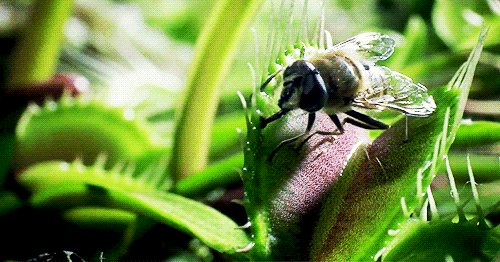
Who are like. The least efficient/effective hunters of the bunch!!
What about these freaky looking beauties??
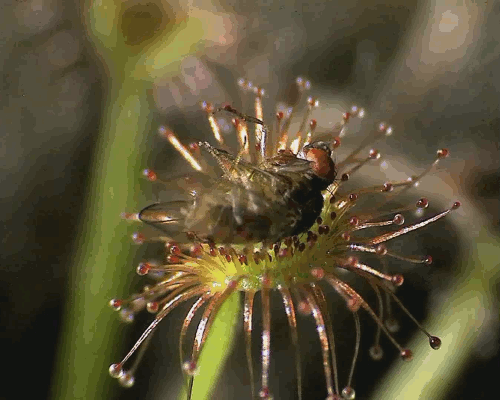
Sundews are so awesome that Charles Darwin literally said that he cares more about them than he does any other species!!
You’ve also go nature’s flypaper, the butterwort:
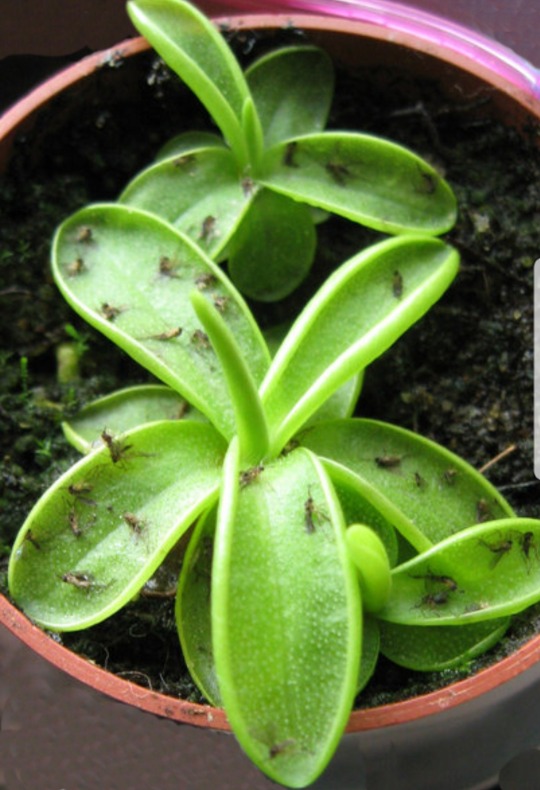
Then you’ve got your aquatic carnivorous plants that eat tiny FISH
Like the VFT of the water, the waterwheel plant
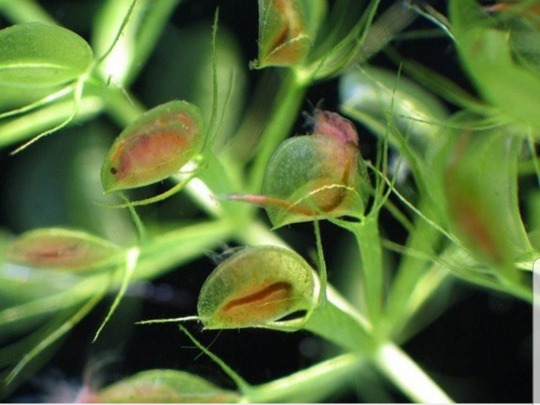
Or the fastest moving plant in the world! The bladderwort sucks its prey in so fast you gotta slow down the footage/capture it with a high-speed camera!! It practically looks like the prey teleports into the goddamn chambers!!
And look how freaky and alien it looks from the surface!!
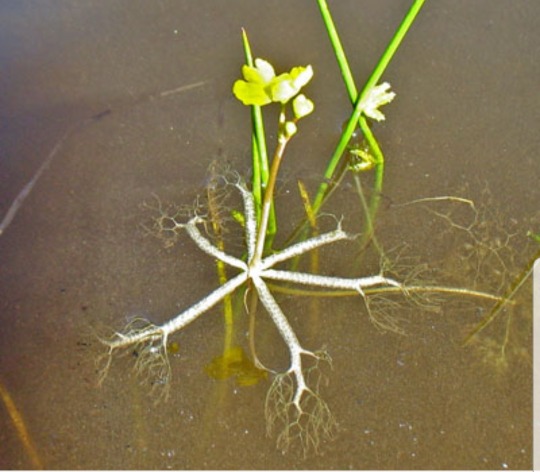
And then there are the pitchers!! There’s SO MANY different kinds!!
You got your gorgeous sarracenia
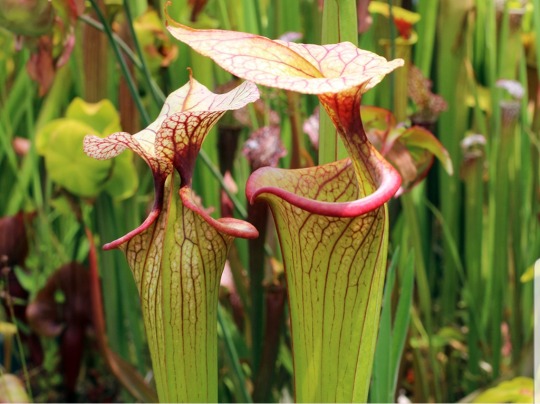
And then there’s the expert hunter, the Cobra lily - a species that Darwin couldn’t wrap his head around. He couldn’t understand how natural evolution could make something so “perfect”!!
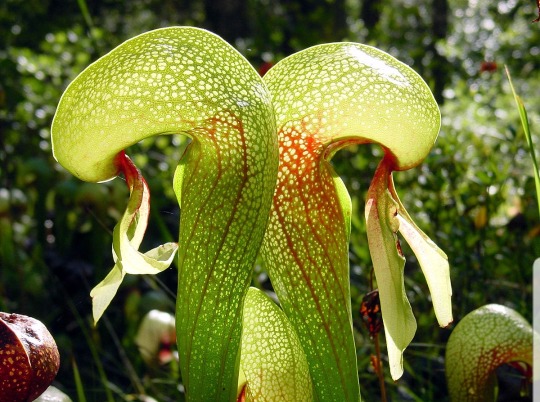
And then of course you’ve got your nepenthes.
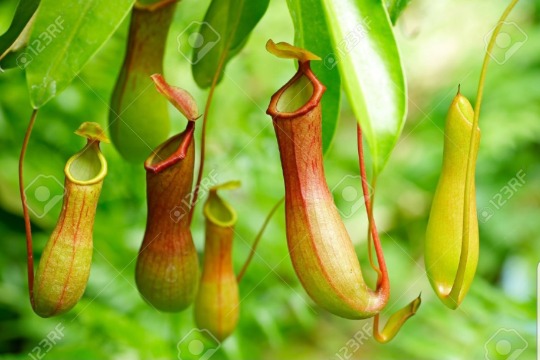
The biggest of which can eat small mammals like mice!! It’s even had RATS fall into it!! (I will note though that it prefers insects, but is just able to eat larger prey bc of its size)
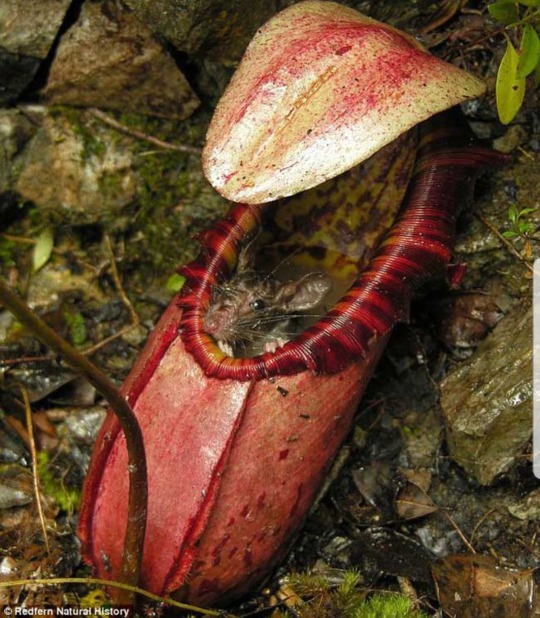
I could go on (I mean didn’t even talk about HOW these plants catch their prey!) But I think you get the idea.
Carnivorous plants are cool ok. Share the spotlight a lil bit.
38K notes
·
View notes
Text
What's bugging you?
https://www.lamorindaweekly.com/archive/issue1312/Digging-Deep-with-Goddess-Gardener-Cynthia-Brian-Whats-bugging-you.html
Digging Deep with Goddess Gardener, Cynthia Brian
What’s Bugging You? by Cynthia Brian
“…many plants of many kinds, with birds singing on the bushes, with various insects flitting about, and with worms crawling through the damp earth.” Charles Darwin
Twenty-three honeybees, ten lady beetles, five lizards, three frogs, and several spiders.
Within two hours on a very hot day this past week, the rescue count from the swimming pool kept mounting. I was afraid to leave the water lest more of my garden friends would drown. It’s summer and the flying insects, creepy crawlies, and slithering creatures are in abundance. The ones I want to save are the ones that are our garden guardians.
The Good Guys
Bees We’ve all heard about the Colony Collapse Disorder affecting honey bees worldwide and the importance of protecting our all bees. Don’t confuse honey bees with carnivorous yellowjackets. Bees, bumble bees, and yellowjackets are all pollinators yet honey bees and bumble bees don’t attack humans unless they are stepped on, slapped, swatted, or threatened. They are gathering pollen and the honey bees are making honey while keeping our fruit, flowers, and vegetables reproducing.
Lady Beetles There are over 450 species of ladybugs in the United States and they are voracious consumers of aphids, caterpillars, lace bugs, mealybugs, scale, whiteflies, and mites. Lady beetles are perhaps the most beloved of all insects and even though you can purchase them for your garden, they will fly away when their food level declines. An adult will eat over 5,000 aphids in her lifetime.
Lizards Don’t be afraid of these garden helpers. Lizards are carnivores, not plant-eaters. You are fortunate if you have lizards in your yard. They eat beetles, ants, wasps, aphids, and grasshoppers. They like to bask in the sun and also shelter under rocks or in the mulch. Predators to lizards include cats, snakes, and birds.
Frogs Both frogs are toads are amphibians living on both land and in water. They need moisture to survive and prey upon snails, slugs, and other insects. However, if they fall into a swimming pool without a way to escape, they will drown. In one summer, a single toad may devour over 10,000 pests. Some species will eat mosquito larvae. Like our lizard friends, pets, birds, and snakes enjoy them as a meal. Enjoy their choral music at dusk.
Spiders Fear of spiders is one of the most common phobias even though most spiders do not bite humans. The two biting spiders with venom that can be fatal to humans are the black widow and the brown recluse. Spiders are not insects. Spiders are arthropods as they have eight legs. As happy hunters, they are excellent garden pest control managers, actually considered to be the most beneficial and efficient insect eradicator in our landscapes. When you see a spider web, admire its delicate intricacy. Don’t destroy it. Inside your home, spiders are helping eradicate more invasive bugs. Spiders don’t carry diseases like mosquitoes or ticks.
To keep the good guys attracted to our landscapes, eliminate pesticides, insecticides, and chemicals. Companion planting with a diversity of species will provide a variety of stalking and dining options. Offer shelters of mulch, rocks, small branches, and a water source.
The Bad Guys
Mosquitoes Mosquito bites cause puffy red bumps that can itch for a week. Worse, mosquitoes are vectors for West Nile Virus that they transmit to humans. Empty any standing water around your garden and punch drainage holes in containers. Change birdbaths daily or add a re-circulating pump. If you have a pool or hot tub, keep it effectively chlorinated. Check for leaky faucets. It only takes a few days for larvae to mature. Vector Control is available at no charge to add mosquitofish (Gambusia affinis) to your pond water.
Yellowjackets Although yellowjackets do help with pollination, they are scavengers for meat and sugary food, disrupting picnics, summer outdoor activities, and barbecues. Never squash a yellowjacket. When crushed they emit a chemical that calls to other yellowjackets to attack. They build nests in abandoned burrows, in eaves, and bushes. Because their sting is so potent and painful, if you find a nest, call Vector Control for eradication.
Ticks Lyme disease is one of the fastest-growing epidemics with over 300,000 diagnoses occurring annually in the United States. Summer is the most likely time to be bitten by a tiny deer tick. Ticks are parasites that feed on blood. They live in brush piles, leaf litter, lawns, tree stumps, ground cover, and stone or brick walls. They even have been found on picnic tables and benches. It’s important to wear tick repellent clothing when outside and after being outdoors, conduct a full body check, take a shower, and put your clothes in a hot dryer for thirty minutes to kill any ticks, then wash your clothes. (I know, it seems weird to dry first, then wash, but the heat of the dryer kills the ticks) Check your pets. Ticks can be hard to find and can linger in your hair, clothing, or pet fur. If you find a tick, don’t twist it or turn it. Use sanitized pointed tweezers to grab the tick and pull it straight out. Wash the bite, apply antiseptic, save the tick for identification, and seek medical attention.
The “bad guys” are on my ‘danger watch out” list. I’ve had three trips already to either urgent care or the emergency room with ticks lodged in my neck that required surgery to remove. Mosquitoes are my nemesis inflicting gigantic, itching bites with bumps that last for two weeks or more. In the last year, I’ve stumbled upon three yellowjacket nests, suffering multiple stings on my hand and arms with swelling that abated after a week.
The “good guys” I’ll continue to rescue as they are my garden “watchdogs” along with the numerous birds and hummingbirds that thankfully aren’t nose-diving!
What’s bugging you?
Cynthia Brian’s Gardening Guide for August
CONTACT Vector Control for Contra Costa County at 925-685-9301for assistance with mosquitoes, rats, skunks, and yellowjackets. PROTECT yourself with permethrin-treated clothing and bug repellents. I have found relief with Insect Shield. www.insectshield.com. PLAN a trip to a national park. Upcoming days for FREE admittance are August 25 and September 28. https://www.nps.gov/findapark/index.htm. Seniors can buy a lifetime entry pass for $80. TAKE advantage of 20% discount on new introductions from Renee’s Garden Seeds through 8/18/19 with checkout code NEW20. http://ow.ly/eYZE50uBDE5. MARK your calendar for The National Heirloom Exposition happening at the Sonoma County Fairgrounds September 10-12. http://www.TheHeirloomExpo.com.
FILL a saucer with water to set in your garden for the butterflies, bees, lizards, and other small creatures. In the hot weather, they need to hydrate and a shallow saucer will allow them to drink without drowning. PRUNE low hanging branches on redwoods, pines, cedars, and other trees as fire protection maintenance. CUT a branch with a magnolia bloom for a vase. The huge white blossoms are spectacular and last several days while the leaves stay green for two weeks. CAUTION when walking or playing on lawns planted with clover. Honeybees may be feeding. CELEBRATE the Moraga Pear and Wine Festival with Be the Star You Are!® non-profit and Lamorinda Weekly on Saturday, September 28th. Details at https://www.BetheStarYouAre.org/eventsCONTINUE deadheading spent blossoms on roses and other perennials. EAT fresh fruit as it ripens and pick up any fruit that falls on the ground to discourage a scourge of rodents. RELAX on your patio to savor the summer sky.
Happy Gardening. Happy Growing. Happy Summer!
See photos at https://www.lamorindaweekly.com/archive/issue1312/Digging-Deep-with-Goddess-Gardener-Cynthia-Brian-Whats-bugging-you.html
Cynthia Brian, The Goddess Gardener, raised in the vineyards of Napa County, is a New York Times best-selling author, actor, radio personality, speaker, media and writing coach as well as the Founder and Executive Director of Be the Star You Are!® 501 c3. Tune into Cynthia’s Radio show and order her books at www.StarStyleRadio.com. Buy a copy of her new books, Growing with the Goddess Gardener and Be the Star You Are! Millennials to Boomers at www.cynthiabrian.com/online-store.
Hire Cynthia for projects, consults, and lectures. [email protected]
www.GoddessGardener.com
picnics, pools, parties, #bugs, #insects, #lizards, #bees, #pest, #yellowjackets, dining outside, summer, patios,#gardening, #cynthiabrian, #starstyle, #goddessGardener, #growingwiththegoddessgardener, #lamorindaweekly
0 notes
Text
What's bugging you?
https://www.lamorindaweekly.com/archive/issue1312/Digging-Deep-with-Goddess-Gardener-Cynthia-Brian-Whats-bugging-you.html
Digging Deep with Goddess Gardener, Cynthia Brian
What’s Bugging You? by Cynthia Brian
“…many plants of many kinds, with birds singing on the bushes, with various insects flitting about, and with worms crawling through the damp earth.” Charles Darwin
Twenty-three honeybees, ten lady beetles, five lizards, three frogs, and several spiders.
Within two hours on a very hot day this past week, the rescue count from the swimming pool kept mounting. I was afraid to leave the water lest more of my garden friends would drown. It’s summer and the flying insects, creepy crawlies, and slithering creatures are in abundance. The ones I want to save are the ones that are our garden guardians.
The Good Guys
Bees We’ve all heard about the Colony Collapse Disorder affecting honey bees worldwide and the importance of protecting our all bees. Don’t confuse honey bees with carnivorous yellowjackets. Bees, bumble bees, and yellowjackets are all pollinators yet honey bees and bumble bees don’t attack humans unless they are stepped on, slapped, swatted, or threatened. They are gathering pollen and the honey bees are making honey while keeping our fruit, flowers, and vegetables reproducing.
Lady Beetles There are over 450 species of ladybugs in the United States and they are voracious consumers of aphids, caterpillars, lace bugs, mealybugs, scale, whiteflies, and mites. Lady beetles are perhaps the most beloved of all insects and even though you can purchase them for your garden, they will fly away when their food level declines. An adult will eat over 5,000 aphids in her lifetime.
Lizards Don’t be afraid of these garden helpers. Lizards are carnivores, not plant-eaters. You are fortunate if you have lizards in your yard. They eat beetles, ants, wasps, aphids, and grasshoppers. They like to bask in the sun and also shelter under rocks or in the mulch. Predators to lizards include cats, snakes, and birds.
Frogs Both frogs are toads are amphibians living on both land and in water. They need moisture to survive and prey upon snails, slugs, and other insects. However, if they fall into a swimming pool without a way to escape, they will drown. In one summer, a single toad may devour over 10,000 pests. Some species will eat mosquito larvae. Like our lizard friends, pets, birds, and snakes enjoy them as a meal. Enjoy their choral music at dusk.
Spiders Fear of spiders is one of the most common phobias even though most spiders do not bite humans. The two biting spiders with venom that can be fatal to humans are the black widow and the brown recluse. Spiders are not insects. Spiders are arthropods as they have eight legs. As happy hunters, they are excellent garden pest control managers, actually considered to be the most beneficial and efficient insect eradicator in our landscapes. When you see a spider web, admire its delicate intricacy. Don’t destroy it. Inside your home, spiders are helping eradicate more invasive bugs. Spiders don’t carry diseases like mosquitoes or ticks.
To keep the good guys attracted to our landscapes, eliminate pesticides, insecticides, and chemicals. Companion planting with a diversity of species will provide a variety of stalking and dining options. Offer shelters of mulch, rocks, small branches, and a water source.
The Bad Guys
Mosquitoes Mosquito bites cause puffy red bumps that can itch for a week. Worse, mosquitoes are vectors for West Nile Virus that they transmit to humans. Empty any standing water around your garden and punch drainage holes in containers. Change birdbaths daily or add a re-circulating pump. If you have a pool or hot tub, keep it effectively chlorinated. Check for leaky faucets. It only takes a few days for larvae to mature. Vector Control is available at no charge to add mosquitofish (Gambusia affinis) to your pond water.
Yellowjackets Although yellowjackets do help with pollination, they are scavengers for meat and sugary food, disrupting picnics, summer outdoor activities, and barbecues. Never squash a yellowjacket. When crushed they emit a chemical that calls to other yellowjackets to attack. They build nests in abandoned burrows, in eaves, and bushes. Because their sting is so potent and painful, if you find a nest, call Vector Control for eradication.
Ticks Lyme disease is one of the fastest-growing epidemics with over 300,000 diagnoses occurring annually in the United States. Summer is the most likely time to be bitten by a tiny deer tick. Ticks are parasites that feed on blood. They live in brush piles, leaf litter, lawns, tree stumps, ground cover, and stone or brick walls. They even have been found on picnic tables and benches. It’s important to wear tick repellent clothing when outside and after being outdoors, conduct a full body check, take a shower, and put your clothes in a hot dryer for thirty minutes to kill any ticks, then wash your clothes. (I know, it seems weird to dry first, then wash, but the heat of the dryer kills the ticks) Check your pets. Ticks can be hard to find and can linger in your hair, clothing, or pet fur. If you find a tick, don’t twist it or turn it. Use sanitized pointed tweezers to grab the tick and pull it straight out. Wash the bite, apply antiseptic, save the tick for identification, and seek medical attention.
The “bad guys” are on my ‘danger watch out” list. I’ve had three trips already to either urgent care or the emergency room with ticks lodged in my neck that required surgery to remove. Mosquitoes are my nemesis inflicting gigantic, itching bites with bumps that last for two weeks or more. In the last year, I’ve stumbled upon three yellowjacket nests, suffering multiple stings on my hand and arms with swelling that abated after a week.
The “good guys” I’ll continue to rescue as they are my garden “watchdogs” along with the numerous birds and hummingbirds that thankfully aren’t nose-diving!
What’s bugging you?
Cynthia Brian’s Gardening Guide for August
CONTACT Vector Control for Contra Costa County at 925-685-9301for assistance with mosquitoes, rats, skunks, and yellowjackets. PROTECT yourself with permethrin-treated clothing and bug repellents. I have found relief with Insect Shield. www.insectshield.com. PLAN a trip to a national park. Upcoming days for FREE admittance are August 25 and September 28. https://www.nps.gov/findapark/index.htm. Seniors can buy a lifetime entry pass for $80. TAKE advantage of 20% discount on new introductions from Renee’s Garden Seeds through 8/18/19 with checkout code NEW20. http://ow.ly/eYZE50uBDE5. MARK your calendar for The National Heirloom Exposition happening at the Sonoma County Fairgrounds September 10-12. http://www.TheHeirloomExpo.com.
FILL a saucer with water to set in your garden for the butterflies, bees, lizards, and other small creatures. In the hot weather, they need to hydrate and a shallow saucer will allow them to drink without drowning. PRUNE low hanging branches on redwoods, pines, cedars, and other trees as fire protection maintenance. CUT a branch with a magnolia bloom for a vase. The huge white blossoms are spectacular and last several days while the leaves stay green for two weeks. CAUTION when walking or playing on lawns planted with clover. Honeybees may be feeding. CELEBRATE the Moraga Pear and Wine Festival with Be the Star You Are!® non-profit and Lamorinda Weekly on Saturday, September 28th. Details at https://www.BetheStarYouAre.org/eventsCONTINUE deadheading spent blossoms on roses and other perennials. EAT fresh fruit as it ripens and pick up any fruit that falls on the ground to discourage a scourge of rodents. RELAX on your patio to savor the summer sky.
Happy Gardening. Happy Growing. Happy Summer!
See photos at https://www.lamorindaweekly.com/archive/issue1312/Digging-Deep-with-Goddess-Gardener-Cynthia-Brian-Whats-bugging-you.html
Cynthia Brian, The Goddess Gardener, raised in the vineyards of Napa County, is a New York Times best-selling author, actor, radio personality, speaker, media and writing coach as well as the Founder and Executive Director of Be the Star You Are!® 501 c3. Tune into Cynthia’s Radio show and order her books at www.StarStyleRadio.com. Buy a copy of her new books, Growing with the Goddess Gardener and Be the Star You Are! Millennials to Boomers at www.cynthiabrian.com/online-store.
Hire Cynthia for projects, consults, and lectures. [email protected]
www.GoddessGardener.com
picnics, pools, parties, #bugs, #insects, #lizards, #bees, #pest, #yellowjackets, dining outside, summer, patios,#gardening, #cynthiabrian, #starstyle, #goddessGardener, #growingwiththegoddessgardener, #lamorindaweekly
0 notes
Text
9 Plants that repel Unwanted Insects


There is a growing epidemic around the world caused by unwanted insects specially mosquitoes. Many major diseases that are caused by mosquitoes around the world include dengue fever , malaria , zika, chickengunia,etc. Researchers have come up with new synthetic ways to eliminate these threats but these measures have some side-effects and often cause harm to human consumers and pets as well.If used in high quantity like DDT is used,Cancer and many lung disorders can be caused.

Whatever science or research may say,there are many plants that have natural abilities to repel unwanted insects like mosquitoes , flies , rats , termite etc.

We proudly present these 9 plants which not only keep your environment and atmosphere free from insects,but have many other natural benefits for your health and body as well:
Lavender
Lavender oil has been used as a bug repellent for many centuries. Lavender was used in the past to protect clothes and linens from the infestation of moths and other insects. Lavender oil is used to prevent mosquitoes bites. Lavender is analgesic, insecticidal, antiseptic and calming. These healing properties of lavender are suitable in both preventing as well as soothing insect bites and stings.

The most unique face about lavender is that unlike some oils that are used to ward off insects, lavender oil isn't burned in candle form or sprayed as an aerosol.Lavender Oil nourishes your skin with no side-effects. Its aroma is also pleasant when compared to other strong-smelling mosquito repellent creams.The scent of lavender oil also acts as a relaxant and encourages sleep. Major Benefits of Lavender are :

Protecting Other Plants Lavender can act as a protector for other plants that lack natural abilities to ward off unwanted insects. While birds and bees feed freely from lavender, nearly all other creepy insects avoid its essential oil. Planting lavender near fruit trees can help prevent its infestation with nasty bugs like coddling moths and white flies. Combating Biting Bugs

Lavender oil can be used as a bug repellent for both humans and pets when they venture outside. A mist made with lavender oil, lemon and witch hazel applied generously can keep fleas off you throughout the season. Lavender works especially well when combined with other essential oils like citronella. Rubbing lavender on your pulse points -- such as behind the ears and insides of the wrists -- allows the essential oils to be dissipated by your body heat. Keeping away Houseflies

Lavender is useful to have in the kitchen because it keeps away houseflies from hanging around. Planting lavender bushes close to the entryways of your home, or even hanging cut sprigs of lavender near doors can also keep many pesky bugs from crossing your threshold.Lavender oil also prevents infections caused by bug bites and controls the itching and inflammation associated with bug bites. Lavender oil also helps control the infestation of fleas, black flies, black beetles, flies, greenflies and white flies.

Basil or Tulsi
Basil,also known as Tulsi is known to have repellent properties against houseflies , mosquitoes and ants.Basil is delicious too and generally used with tea,salad , tomatoes,etc to improve flavor and odor.

It can be planted inside your house or outside wherever you want to relax and entertain yourself since Basil is said to have soothing properties as well. Basil can repel certain species of spiders and cockroaches as well. Although more than 60 varieties of basil have been identified, they all fall into three main types: Sweet Purple Bush Each offers a subtle difference in taste.Basil plants are easy to maintain both indoors as well as outdoors. There is a popular belief that light attracts mosquitoes and points them towards potential blood

donors viz. us.This is not entirely true.The fact is that these insects have other senses as well.They have an in-built thermal and chemical sensor,to locate their targets. They have a tarsi in the third pair of their legs which notifies them about any temperature difference around their prey.The antennae of a mosquito detects the steam and carbon dioxide that we exhale or exude, along with some other substances that we exhale from our dermis/skin or by the bacteria living on it, such as the lactic acid in our sweat.

Mosquito repellents usually affect an insect's sensors, removing their ability to detect targets, so they go away in order to recover them. Among the list of natural volatile compounds that can be used as repellents there are Pyrethrins Methyl-nonyl-ketone Geraniol Estragole Citronellal Limonene Nerolidol

Some of the plants that have traditionally been considered repellents synthesise at least one of the above mentioned substances.Basil (Ocimum basilicum), has not one, but four of these mosquito-repellent volatiles, among which there is a predominance of estragole (1-allyl-4-methoxybenzene), also known as tarragon, methylchavicol or allylanisole. They are as follows : Estragole Citronellal Limonene Nerolidol In addition, estragole is one of the elements responsible for the typical scent that basil releases when its leaves are rubbed. Tonnes and tonnes of basil oil is produced via steam distillation every year.

Lemon Grass


You’ve no doubt seen citronella candles in stores during the summer season.Citronella keeps mosquitoes away. Citronella is a natural oil found in lemongrass, an ornamental that can grow up to 4 feet tall and 3 feet wide in one season. It does well in a pot or in the ground in a sunny, well-drained location. Use its fragrance, narrow leaves in chicken and pork dishes and to flavor soups and salad dressing. Many Asian recipes call for lemongrass.

If we assume for a moment, that aroma from this plant wards off mosquitoes, then it is effective for you if you are sitting in or right next to the plant. But the reality is that amount of chemicals given off by plants is very small. You will smell them most when you brush against them or you crush a leaf. Research has confirmed that citronella oil is registered as an insect repellent in the US. Studies in the EU failed to validate its effectiveness and they have banned the product as an insecticide.

Alliums

Plants in the Allium family, such as the dramatic Allium giganteum whose flower heads adorn stalks up to 6 feet tall, are regarded as a broad-spectrum natural insecticide. They repel numerous insects that are found in vegetable gardens, including slugs, aphids, carrot flies and cabbage worms. Plants that will benefit from the proximity of alliums include: Tomatoes Peppers Potatoes Cabbage Broccoli Kohlrabi Carrots

They also keep aphids away from rose bushes. Alliums include small-growing herbs such as chives, garlic chives, leeks and shallots.

Marigold

Marigold has many abilities,It can repel mosquitoes , rabbits, grasshopper , spiders , termites and beetels .Marigold is used to extract essential oil by steam distillation.It's oil is really expensive and used in many perfumes and deodorants.The roots of marigolds are well-known among farmers to repel nematodes, though these qualities take an year to take effect.

Annual Marigolds can be used anywhere to deter Mexican bean beetles, squash bugs, thrips, tomato hornworms, and whiteflies. They are also known to repel harmful root knot nematodes (soil dwelling microscopic white worms) that attack tomatoes, potatoes, roses, and strawberries. If a whole area is infested, at the end of the season, turn the Marigolds under so the roots will decay in the soil. You can safely plant there again the following spring.Potted marigolds can be positioned near entrances to your home and any common mosquito entry points, such as open windows. The smell may deter mosquitoes from going past this barrier.The pyrethrum in marigolds is a substance that's used in many repellents. That's because it can protect the skin from mosquito bites for a fair number of hours. In fact, a recent study has found that the essential oil from Calendula officinalis (a kind of marigold) works a lot like deet when it comes to deterring mosquitoes. However, it only does this for about 2 hours.Marigolds can still grow on moist soil. So to stop mosquitoes from laying eggs near your yard’s water features, build a marigold barrier around it.

Petunias

Petunias Repel aphids, tomato horn-worms, asparagus beetles, leaf-hoppers and squash bugs.It is the most effective natural pesticide being used in many synthetic pesticides around the world.This specific ornamental plant is present grown all over the Mediterranean, Asia and America.

Pitcher Plant
Pitcher plants are carnivores plants which feed on house flies , mosquitoes , honeybees etc. https://www.youtube.com/watch?v=bDCUnxcJYSM It is a good option to stop unwanted insects.Pitcher plants have pitfall traps to capture flies and

other insects. When Lucrates fly around this plant they fall in its pit and the pit closes to digests the insect.Pitcher plants are famous for their flesh-eating ways, and they rely on slippery surfaces to trap their prey. Its pitcher-shaped traps are made from rolled up leaves, and secrete nectar from their rims to entice their prey. During wet conditions, the rims are coated with a thin layer of water, making them extremely slippery. They have another trick too – tapering wax crystals on the inner walls of the pitcher. These greatly reduce the surface area that insect feet would cling to, and ensure that individuals that fall inside can’t climb back out. Sarracenia - This North American pitcher plant lures the flies and wasps with nectar, before they fall in. Hairs pointing down spring them back if they try to climb up. It’s too narrow for wings, and if they try to use their wings it creates a vacuum sucking them down.

Rosemary

Rosemary is woody perennial herb and it is an evergreen plant with pointy leaves and wood stem. According to an ancient legend Virgin Mary spread her cloak over rosemary that's why it is known as a rose of Mary.It has urosolic acid , rosemaric acid , camphor which are excellent insect repellents.It is typically prepared as a dried herb or a dried powdered extract, while teas and liquid extracts are made from fresh or dried leaves. The herb has been hailed since ancient times for its medicinal properties. Rosemary was traditionally used to help alleviate muscle pain, improve memory, boost the immune and circulatory system, and promote hair growth.

Rosemary is a rich source of an anti-oxidant and an anti-inflammatory compound, and helps in boosting your immune system and improve blood circulation.Rosemary plays an important role in neutralizing harmful particles called free radicals.In Europe, rosemary is often used to help treat indigestion. In fact, Germany's Commission E has approved rosemary for the treatment of indigestion.

Chrysanthemums
Chrysanthemums repels roaches, ants, Japanese beetles, ticks, silverfish, lice, fleas, bedbugs, spider mites, harlequin bugs and root nematodoes . Pyrethrum is the major element of Chrysanthemums Because pyrethrums can kill flying and jumping insects.They are used in America’s most commonly available home and garden insecticides and are frequently used as indoor sprays, pet shampoos and aerosol bombs. Although chrysanthemum flowers can be used to make an insecticidal spray, pyrethrum can be carcinogenic to humans and care should be taken while using it..

Chrysanthemum 'Astro Dark' Click to Post
#alliums#basil#chikungunya#chrysanthemums#dengue#gardening#insects#lavender#lemon_grass#malaria#marigold#mosquitoes#petunias#pitcher_plants#rosemary#tulsi#zika_virus
0 notes